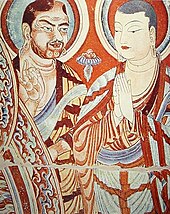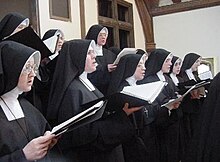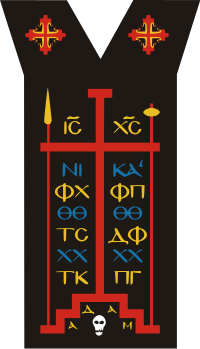

This article needs additional citations for verification. Please help improve this articlebyadding citations to reliable sources. Unsourced material may be challenged and removed.
Find sources: "Religious habit" – news · newspapers · books · scholar · JSTOR (February 2021) (Learn how and when to remove this message) |

| Part of a serieson |
| Western dress codes and corresponding attires |
|---|
|
|
|
|
|
|
|
Casual (anything not above) |
|
Supplementary alternatives |
|
Legend:
|
|
|
Areligious habit is a distinctive set of religious clothing worn by members of a religious order. Traditionally some plain garb recognizable as a religious habit has also been worn by those leading the religious eremitic and anchoritic life, although in their case without conformity to a particular uniform style.
Uniformity and distinctiveness by order often evolved and changed over time. Interpretation of terms for clothes in religious rules could change over centuries. Furthermore, every time new communities gained importance in a cultural area the need for visual separation increased for new as well as old communities. Thus, modern habits are rooted in historic forms, but do not necessarily resemble them in cut, colour, material, detail or use.
InChristian monastic orders of the Catholic, Lutheran and Anglican Churches, the habit often consists of a tunic covered by a scapular and cowl, with a hood for monksorfriars and a veil for nuns; in apostolic orders it may be a distinctive form of cassock for men, or a distinctive habit and veil for women. Catholic Canon Law requires only that the garb of their members be in some way identifiable so that the person may serve as a witness of the Evangelical counsels.
In many orders, the conclusion of postulancy and the beginning of the novitiate is marked by a ceremony, in which the new novice is accepted as a novice and then clothed in the community's habit by the superior. In some cases the novice's habit will be somewhat different from the customary habit: for instance, in certain orders of women that use the veil, it is common for novices to wear a white veil while professed members wear black, or if the order generally wears white, the novice wears a grey veil. Among some Franciscan communities of men, novices wear a sort of overshirt over their tunic; Carthusian novices wear a black cloak over their white habit.

Kāṣāya (Sanskrit: काषाय, romanized: kāṣāya; Pali: kasāva; Chinese: 袈裟; pinyin: jiāshā; Cantonese Jyutping: gaa1saa1; Japanese: 袈裟 kesa; Korean: 袈裟 가사 gasa; Vietnamese: cà-sa), "chougu" (Tibetan) are the robes of Buddhist monks and nuns, named after a brown or saffron dye. In Sanskrit and Pali, these robes are also given the more general term cīvara, which references the robes without regard to color.

Buddhist kāṣāya are said to have originated in India as set of robes for the devotees of Gautama Buddha. A notable variant has a pattern reminiscent of an Asian rice field. Original kāṣāya were constructed of discarded fabric. These were stitched together to form three rectangular pieces of cloth, which were then fitted over the body in a specific manner. The three main pieces of cloth are the antarvāsa, the uttarāsaṅga, and the saṃghāti.[1] Together they form the "triple robe", or tricīvara. The tricīvara is described more fully in the Theravāda Vinaya (Vin 1:94 289).
A robe covering the upper body. It is worn over the undergarment, or antarvāsa. In representations of the Buddha, the uttarāsaṅga rarely appears as the uppermost garment, since it is often covered by the outer robe, or saṃghāti.
The saṃghāti is an outer robe used for various occasions. It comes over the upper robe (uttarāsaṅga), and the undergarment (antarvāsa). In representations of the Buddha, the saṃghāti is usually the most visible garment, with the undergarment or uttarāsaṅga protruding at the bottom. It is quite similar in shape to the Greek himation, and its shape and folds have been treated in Greek style in the Greco-Buddhist artofGandhāra.
Other items that may have been worn with the triple robe were:

In India, variations of the kāṣāya robe distinguished different types of monastics. These represented the different schools that they belonged to, and their robes ranged widely from red and ochre, to blue and black.[2]
Between 148 and 170 CE, the Parthian monk An Shigao came to China and translated a work which describes the color of monastic robes utilized in five major Indian Buddhist sects, called Dà Bǐqiū Sānqiān Wēiyí (Ch. 大比丘三千威儀).[3] Another text translated at a later date, the Śariputraparipṛcchā, contains a very similar passage corroborating this information, but the colors for the Sarvāstivāda and Dharmaguptaka sects are reversed.[4][5]
| Nikāya | Dà Bǐqiū Sānqiān Wēiyí | Śariputraparipṛcchā |
|---|---|---|
| Sarvāstivāda | Deep Red | Black |
| Dharmaguptaka | Black | Deep Red |
| Mahāsāṃghika | Yellow | Yellow |
| Mahīśāsaka | Blue | Blue |
| Kaśyapīya | Magnolia | Magnolia |
In traditions of Tibetan Buddhism, which follow the Mūlasarvāstivāda Vinaya, red robes are regarded as characteristic of the Mūlasarvāstivādins.[6] According to Dudjom Rinpoche from the tradition of Tibetan Buddhism, the robes of fully ordained Mahāsāṃghika monastics were to be sewn out of more than seven sections, but no more than twenty-three sections.[7] The symbols sewn on the robes were the endless knot (Skt. śrīvatsa) and the conch shell (Skt. śaṅkha), two of the Eight Auspicious Signs in Buddhism.[7]
InChinese Buddhism, the kāṣāya is called gāsā (Ch. 袈裟). During the early period of Chinese Buddhism, the most common color was red. Later, the color of the robes came to serve as a way to distinguish monastics, just as they did in India. However, the colors of a Chinese Buddhist monastic's robes often corresponded to their geographical region rather than to any specific schools.[2] By the maturation of Chinese Buddhism, only the Dharmaguptaka ordination lineage was still in use, and therefore the color of robes served no useful purpose as a designation for sects, the way that it had in India.

InJapanese Buddhism, the kāṣāya is known as the kesa (袈裟). In Japan, during the Edo and Meiji periods, kesa were sometimes pieced together from the theatrical kimono used in Noh theatre.

Pope John Paul II in his post-apostolic Exhortation Vita consecrata (1996) says concerning the religious habit of consecrated persons:
§25 [...] The Church must always seek to make her presence visible in everyday life, especially in contemporary culture, which is often very secularized and yet sensitive to the language of signs. In this regard the Church has a right to expect a significant contribution from consecrated persons, called as they are in every situation to bear clear witness that they belong to Christ.
Since the habit is a sign of consecration, poverty and membership in a particular Religious family, I join the Fathers of the Synod in strongly recommending to men and women religious that they wear their proper habit, suitably adapted to the conditions of time and place.
Where valid reasons of their apostolate call for it, Religious, in conformity with the norms of their Institute, may also dress in a simple and modest manner, with an appropriate symbol, in such a way that their consecration is recognizable.
Institutes which from their origin or by provision of their Constitutions do not have a specific habit should ensure that the dress of their members corresponds in dignity and simplicity to the nature of their vocation.


The religious habits of Catholic nuns typically consist of the following elements:
The coif and veil were common items of clothing for married women in medieval Europe.[citation needed]
Different orders adhere to different styles of dress; these styles have changed over time.


This section needs expansion. You can help by adding to it. (February 2021)
|
Historically, the religious habit of Catholic sisters was a visible sign of a woman's consecration to God.[8] Different orders adhere to different styles of dress; these styles have changed over time. For example, in former times, the Daughters of Charity of Saint Vincent de Paul wore a cornette instead of a veil. Due the ecclesiastical document Perfectae caritatis, many congregations decided to simplify their habits, to conform to the attire of the culture they are working in, or to even discard their use entirely.
While styles vary, for those wearing the traditional habit, three pieces are consistently worn: tunic (robe), belt/cincture, veil. The habit of some Dominican Sisters consists of a tunic, belt (cincture), scapular, veil, rosary, and on formal occasions a cappa (mantle).[9] Even for orders that have chosen not to wear a habit, these sisters often share a common appearance: calf-length skirt, blouse or sweater, visible cross necklace.

Monks in the Catholic church wear a tunic, a cincture, a hooded scapular, and, for the Liturgy of the Hours, a mantle (novices) or a cowl (professed monks).[citation needed]
This section needs expansion. You can help by adding to it. (February 2021)
|
This section needs expansion. You can help by adding to it. (February 2021)
|
Owing to the different traditions and origins that exist, there is no singular common habit worn by the Canons Regular. Historically the common habit was the distinctive white cassock, with white fascia, over time some communities of Canons have changed to wearing the black cassock with black fascia. The only item of the habit that is common to all Canons is the linen rochet a mark of the canonical status.
In the Netherlands, some wore a cacullae (a small asymmetrical black cope of cloth or sheepskin.) Some communities of canons, notably in Austria and Switzerland wear a sarotium, coming from the Latin sacrum rochettum, 'the sacred rochet'. It is a thin band of linen worn over the cassock when not in choir. As part of their choir dress, some communities of Canons wear a mozzetta, either black or purple over the rochet.
Outdoors Canons wear a black cloak and hood, but again adaptations have been made to this in some of the communities. Canons also traditionally wore a biretta.
This section needs expansion. You can help by adding to it. (March 2017)
|
Usually, secular priests wear either a black cassock or an ordinary men's garb in black or another dark color along with a white clerical collar. White cassocks or clothes may be worn in hot climates. Also, a ferraiolo (a kind of cope) could be worn along with the cassock. Priests also traditionally wore a biretta along with the cassock.
Deacons, priests, and bishops belonging to religious institutes wear the habit of their institute.
Latin Church clergy other than bishops, in particular any who are abbotsorapostolic prefects or ordinary of a personal ordinariate, may wear pontifical items. Mitre, crosier and ring are bestowed on an abbot at his blessing and the pectoral cross is a customary part of an abbatial habit.[citation needed]
InLutheranism, various religious orders have a habit of a different colour. The Daughters of Mary wear a blue habit.[10]

The Eastern Orthodox Church does not have distinct religious orders such as those in the Catholic Church. The habit (Greek: Σχήμα, romanized: Schēma) is essentially the same throughout the world. The normal monastic color is black, symbolic of repentance and simplicity. The habits of monks and nuns are identical; additionally, nuns wear a scarf, called an apostolnik. The habit is bestowed in degrees, as the monk or nun advances in the spiritual life. There are three degrees: (1) the beginner, known as the Rassaphore ('robe bearer') (2) the intermediate, known as the Stavrophore ('cross bearer'), and (3) the Great Schema worn by Great Schema Monks or Nuns. Only the last, the Schemamonk or Schemanun, the monastic of the highest degree, wears the full habit.
The habit is formally bestowed upon monks and nuns at the ceremony known as the tonsure (Greek κουρά). The parts of the Eastern Orthodox habit are:

The portions of the habit worn by the various degrees of monastics is as follows:
| Rasophore | Stavrophore | Great Schema |
|---|---|---|
| Inner Rason | Inner Rason | Inner Rason |
| Belt | Belt | Belt |
| Paramand | Paramand | |
| Outer Rason | Outer Rason | Outer Rason |
| Analavos | ||
| Mantle (Russian use only) | Mantle | |
| Polystavrion | ||
| Kalymafki | Kalymafki | Koukoulion |
This section needs expansion. You can help by adding to it. (March 2017)
|
In Hinduism, religious clothing is a huge element of an individual’s life. [citation needed] Most Hindus are known to wear a religious pendant in their daily life to show their faith in God. Hindu women cover their heads with scarf as a sign of respect for not only religion but also their husbands. [citation needed]
In India, most devoted Hindus are seen wearing a tilak and orange clothing depicting devotion to their religion. [citation needed] Most Hindu Pandits are either seen in a white or orange (kesari) religious clothing in India. [citation needed]
Brahmin Hindus are most known for their devotion to the religion among all Hindus. They are seen wearing religious habits at various important moments in their life. [citation needed]
Islam does not have religious habits or monastic orders. Muslim ascetics do not have particular uniforms, but rather dress in humble clothing appropriate to their era and region.[citation needed]
Female ascetics and Śvetāmbara male monks always wear un-stitched or minimally stitched white clothes. Digambara Jain monks do not wear clothes. A loin cloth which reaches up to the shins is called a Cholapattak. Another cloth to cover the upper part of the body is called Pangarani (Uttariya Vastra). A cloth that passes over the left shoulder and covers the body up to a little above the ankle is called a Kïmli. Kïmli is a woolen shawl. They also carry a woolen bed sheet and a woolen mat to sit on. Those who wear clothes have a muhapati, which is a square or rectangular piece of cloth of a prescribed measurement, either in their hand or tied on their face covering the mouth. Śvetāmbara ascetics have an Ogho or Rajoharan (a broom of woolen threads) to clean insects around their sitting place or while they are walking. Digambara ascetics have a Morpichhi and a Kamandal in their hands. This practice may vary among different sects of Jains but essential principle remains the same to limit needs.
In Japan, various types of very traditional dress are worn by Shinto priests, often dating to styles worn by nobles during the Nara periodorHeian period.
Hakama (袴) are a type of traditional Japanese clothing, originally worn only by men, but today they are worn by both sexes. There are two types, divided umanori (馬乗り, "horse-riding hakama") and undivided andon bakama (行灯袴, "lantern hakama"). The umanori type have divided legs, similar to trousers, but both types appear similar. Hakama are tied at the waist and fall approximately to the ankles, and are worn over a kimono (hakamashita), with the kimono then appearing like a shirt.
AJōe (浄衣) is a garment worn in Japan by people attending religious ceremonies and activities, including Buddhist and Shinto related occasions. Not only Shinto and Buddhist priests can be found wearing Jōe at rituals, but laymen as well, for example when participating in pilgrimage such as the Shikoku Pilgrimage. The garment is usually white or yellow and is made of linen or silk depending on its kind and use. The Shinto priest who wears the jōe is attired in a peaked cap called tate-eboshi, an outer tunic called the jōe proper, an outer robe called jōe no sodegukuri no o, an undergarment called hitoe, ballooning trousers called sashinukiornubakama, and a girdle called jōe no ate-obi.